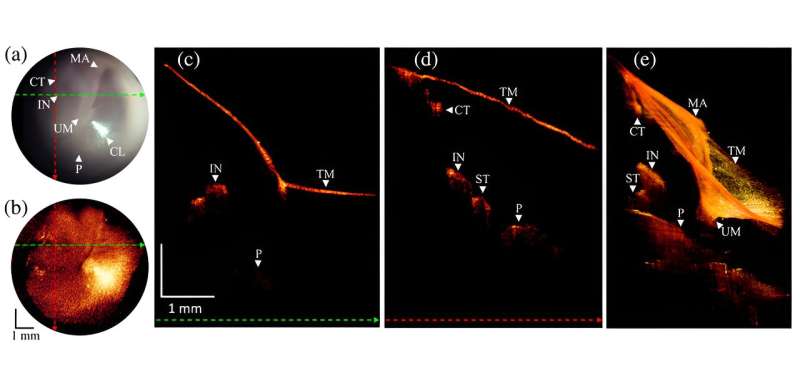This article has been reviewed according to Science X's editorial process and policies. Editors have highlighted the following attributes while ensuring the content's credibility:
fact-checked
peer-reviewed publication
trusted source
proofread
New imaging device improves ear disease diagnosis

In the realm of ear health, accurate diagnosis is crucial for effective treatment, especially when dealing with conditions that can lead to hearing loss. Traditionally, otolaryngologists have relied on the otoscope, a device that provides a limited view of the eardrum's surface. This conventional tool, while useful, has its limitations, particularly when the tympanic membrane (TM) is opaque due to disease.
Enter a groundbreaking advancement from the University of Southern California's Caruso Department of Otolaryngology: a portable OCT otoscope that integrates optical coherence tomography (OCT) with the traditional otoscope, to improve diagnostic capabilities in hearing clinics. As reported in Journal of Biomedical Optics, the integrated device allows clinicians to obtain detailed views of both the surface and the deeper structures of the eardrum and middle ear, enabling a more comprehensive picture of ear health and improving diagnostic accuracy.
Traditional otoscopes only allow for a superficial examination of the TM, often missing deeper pathologies. In contrast, the OCT otoscope combines the familiar otoscopic view with high-resolution imaging of the inner structures of the TM and middle ear (ME), offering a clearer and more comprehensive view, which can help in diagnosing conditions that were previously missed.
This state-of-the-art device features a 7.4 mm field of view and impressive lateral and axial resolutions of 38 micrometers and 33.4 micrometers, respectively. It also integrates advanced algorithms to enhance image clarity and correct distortions, ensuring precise and reliable results.
During a clinical study at USC Keck Hospital, the researchers tested the OCT otoscope on over 100 patients. These tests demonstrate the new device's ability to reveal pathological features that were previously invisible using standard otoscopy.
Notably, the article showcases a few clinical applications including monitoring myringitis, tympanic membrane perforation healing, retraction pockets, and subsurface scarring / air pockets; the new imaging system identified several critical conditions that were not apparent through traditional methods, offering valuable insights for more effective management and treatment of ear diseases.
The OCT otoscope's design allows for seamless integration into existing clinical workflows, with an easy-to-use interface controlled by a foot pedal for image acquisition. This user-friendly approach ensures that the device can be readily adopted by clinicians, providing them with a powerful new tool for diagnosing and managing TM and ME disorders.
Overall, this advancement marks a significant step forward in otolaryngology, enhancing the precision of ear examinations and potentially leading to better outcomes for patients suffering from hearing loss due to ear pathologies. As this technology becomes more widely available, it promises to transform the way ear health is assessed and treated, offering hope for more accurate diagnoses and improved patient care.
More information: Wihan Kim et al, Optical coherence tomography otoscope for imaging of tympanic membrane and middle ear pathology, Journal of Biomedical Optics (2024). DOI: 10.1117/1.JBO.29.8.086005




















